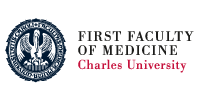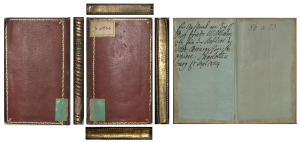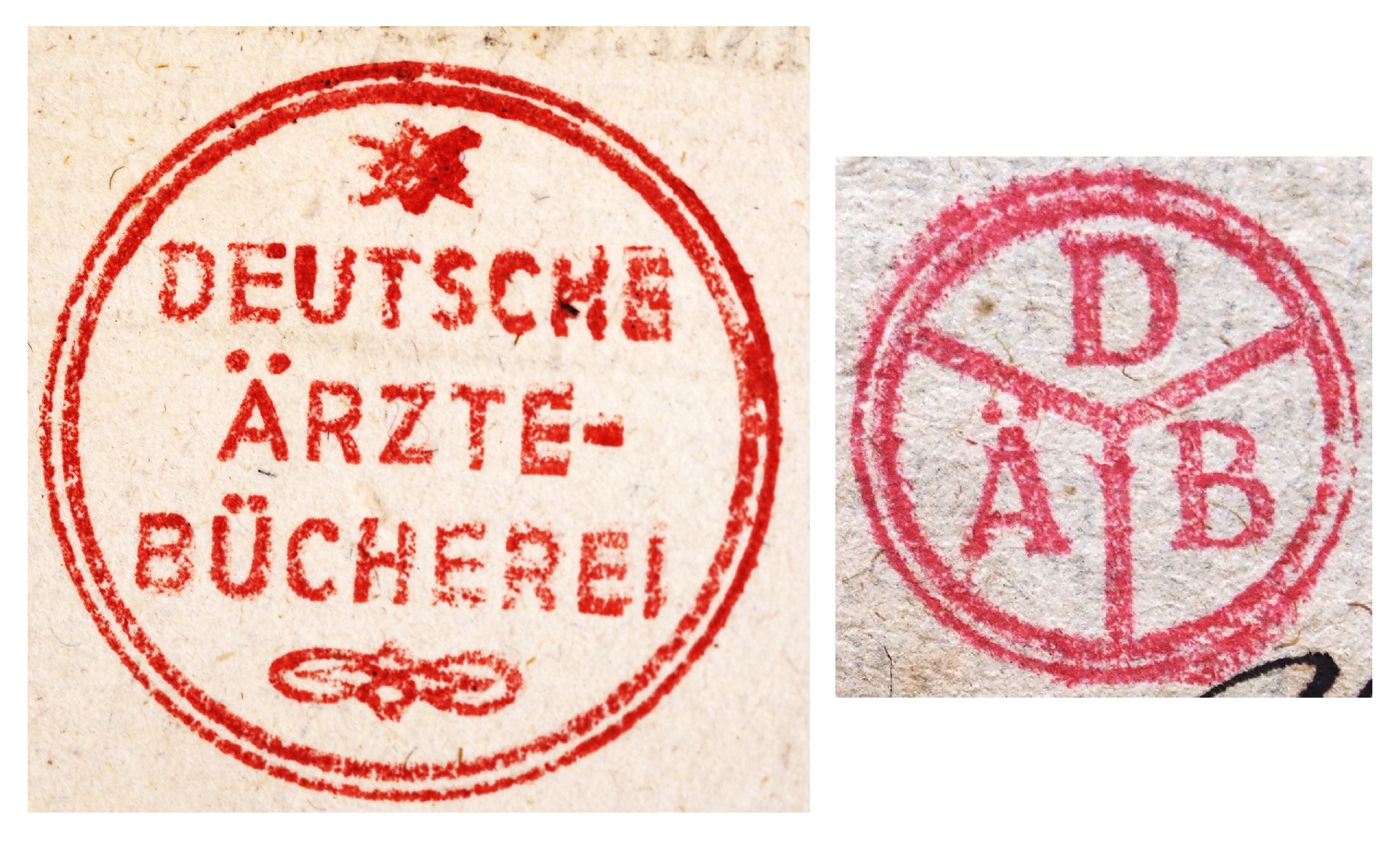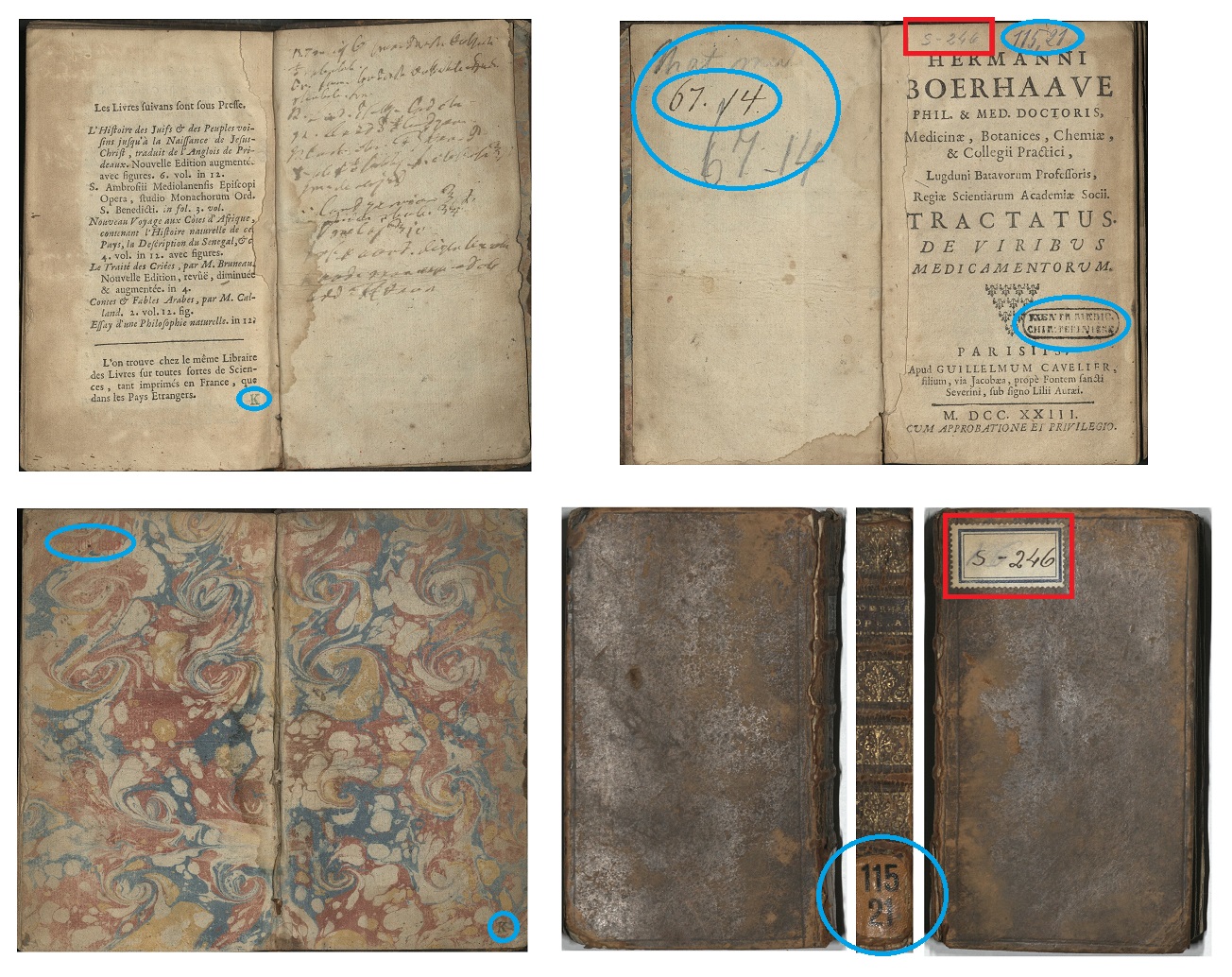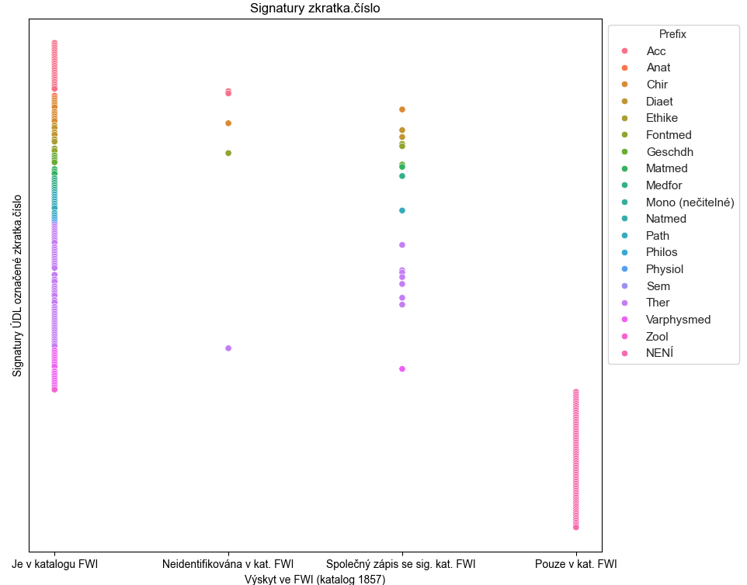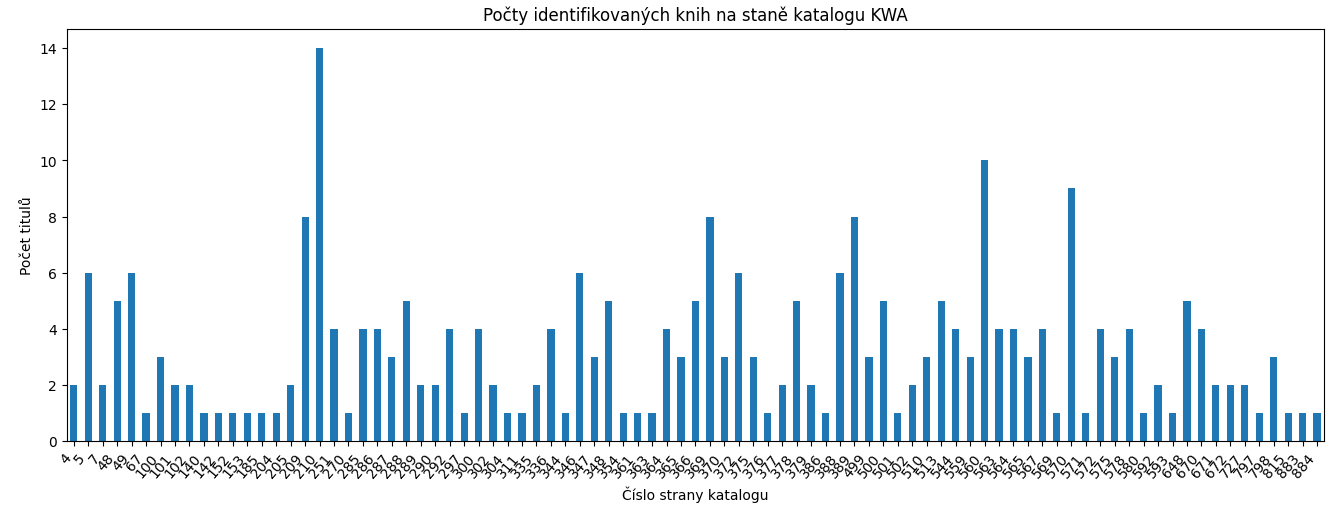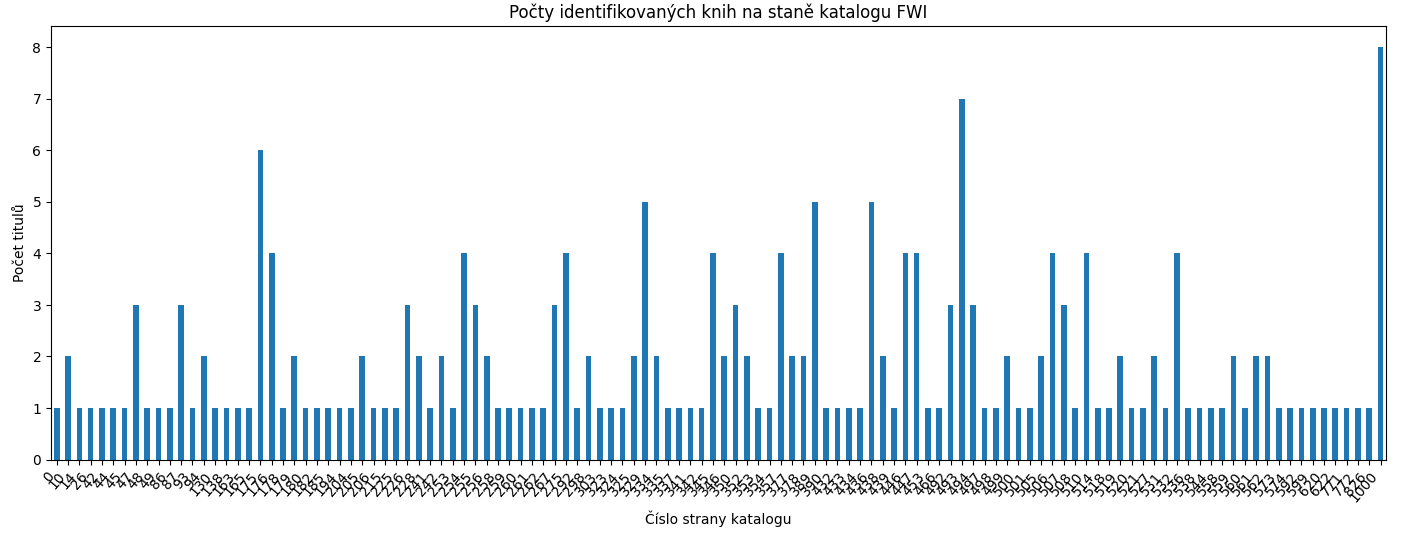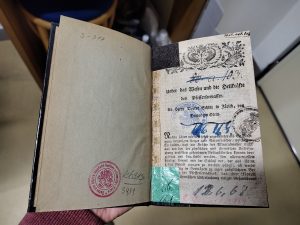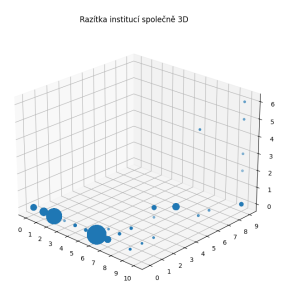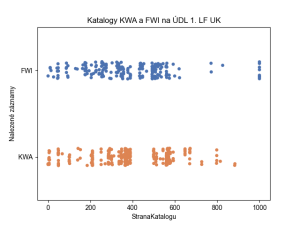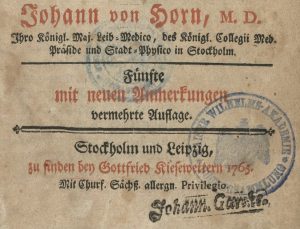Advent of Lost Berlin Libraries – 24
The last post in the advent series of interesting facts about the Berlin collection of rare books at the First Faculty of Medicine of Charles University is a princely gift indeed. At first glance, it captivates with its beautiful red leather binding adorned with gold, bearing the inscription that the book was donated to Pépinière by the Prussian king:
It was king Friedrich Wilhelm III (1770–1840) at Charlottenburg in September 1804. According to the festschrift for Pépinière’s 25 years’ anniversary, he did so frequently. Such books – with a similar inscription and the same binding and gilded edges – exist in the processed third of the collection of rare prints. There are two of them for sure, but I believe that more will be discovered.
Wishing you a generous and joyful Christmas Eve!
Markéta Ivánková, December 24th, 2023
Schmidt, H.: Die Kaiser Wilhelms-Akademie für das militäräztliche Bildungswesen. Von 1895 bis 1910. Festschrift zur Einweihung des Neubaues der Akademie. Im Auftrage der Medizinal-Abteilung des Königlichen Kriegsministeriums. Berlin: G. S. Mittler & Sohn, 1910.
Advent of Lost Berlin Libraries – 23
Today, we will take a look at the spine of the book with the Berlin signature 297.23. It is another in a series of obstetric manuals, but I will focus again on the physical condition of the volume rather than the content of the title itself:
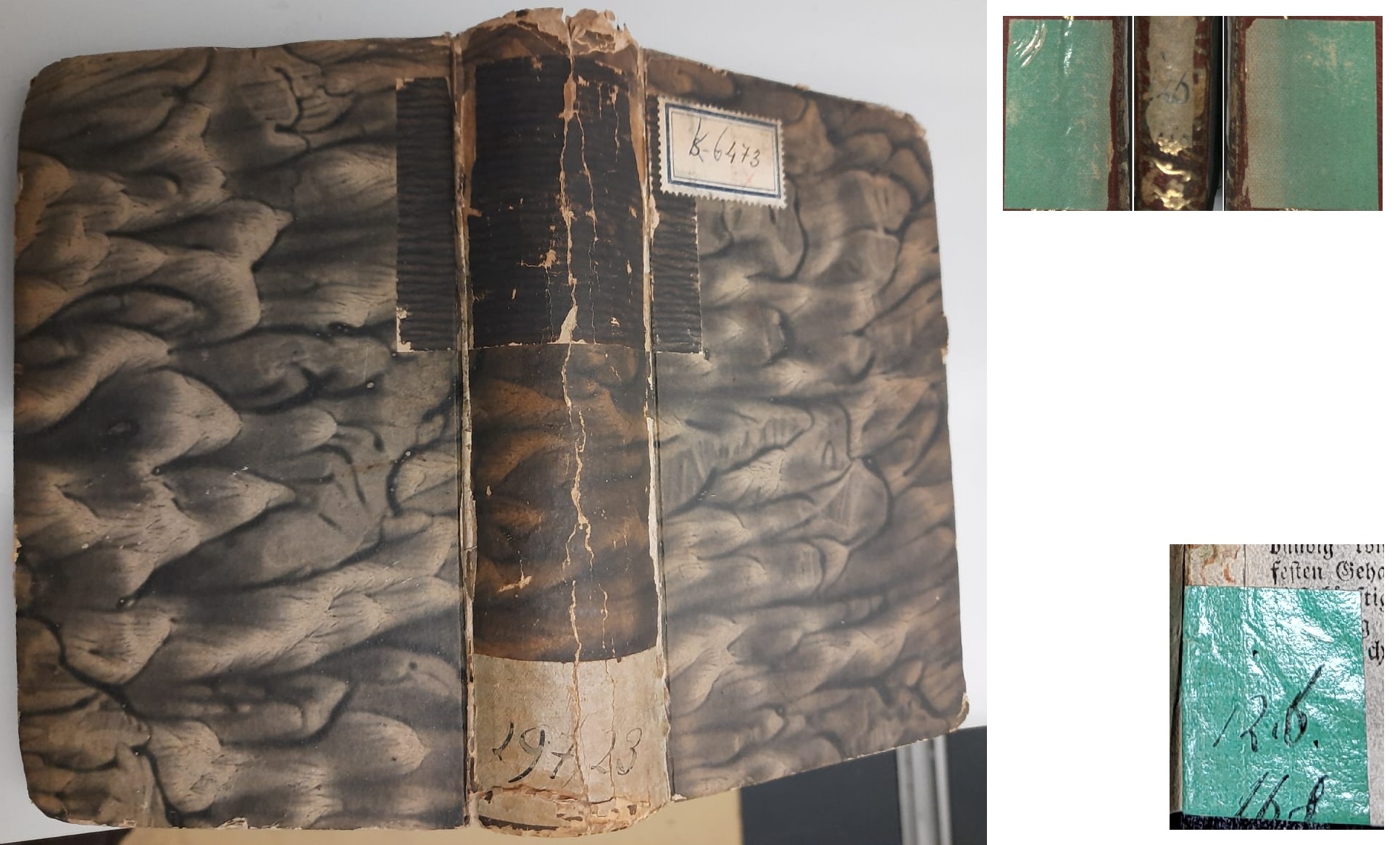 Photo: archive of the Institute ÚVI
Photo: archive of the Institute ÚVI
The volume nicely demonstrates how the originally green spine with Kaiser Wilhelms-Akademie signatures has fared. In my model, I call this type “green” but it is usually completely faded, as seen in today’s illustration. The distinguishing feature is primarily the lettering and the format of the label, not the current shade.
To give you an idea of the original colour, I am adding a comparison with less faded examples of spine labels. In the upper right corner, a clear transition is visible, where the material on the spine has almost completely faded due to UV radiation, while, most of the label on the front and back cover remains in better condition. Residue of the colour is clearly visible there. In the lower right corner, we have a photograph of the hidden unfaded sticker from the spine, which remained concealed inside the newer book binding. Thanks to this, the label has remained closest to its original appearance.
Markéta Ivánková, December 23rd, 2023
Advent of Lost Berlin Libraries – 22
So far, I haven’t shown in detail the stamp of the youngest Berlin institution, although it has been mentioned many times – Deutsche Ärzte-Bücherei. During the examination of the collection of rare prints at the Institute for History of Medicine at the 1st Faculty of Medicine of Charles University, 22 books with the DÄB stamp were found, in a complete or abbreviated and smaller version that appears at the ends of books:
Photo: archive of the Institute ÚVI
This is 13 more beyond the core of the library, which already belonged to the oldest Pépinière. The Deutsche Ärzte-Bücherei functioned as a successor library after the military Kaiser Wilhelms-Akademie was officially dissolved in 1919, and it ceased to exist in 1945.
Some volumes, which were not evacuated from Berlin before the end of the war, were found – for example – in Georgia. By analogy with the evacuated part of the library now of the Faculty of Medicine in Hradec Králové, it is reasonable to attribute the same fate to the Prague books that used to belong to the DÄB. However, separating volumes evacuated before the end of the war from those taken to the Soviet Union will be a smaller puzzle if it is to be proven using direct evidence from the books themselves. The most accurate information so far is the paper reminding to return the book to the DÄB address by December 1943, which I mentioned in the 16th post. And from late 1943 to 1945 it is still a long way.
Markéta Ivánková, December 22nd, 2023
Advent of Lost Berlin Libraries – 21
Today, we will focus on the visual documentation related to all entries of former owners in the book that had the shelf-mark’s sequential number 21 at the Kaiser Wilhelms-Akademie, specifically in the category of pharmacology textbooks (115):
Photo: Jitka Stejskalová
The book of the day is Boerhaave’s Tractatus de viribus medicamentorum, published in Paris in 1723. The current shelf-mark K 6246, as indicated by the label on the book’s cover in a red frame, is an expanded version of the older Czech shelf-mark S-246. We can see the latter written in pencil on the upper edge of the title page, and I have highlighted it with a red rectangle in the photograph as well.
The remaining provenance records now belong to Berlin institutions, which I have highlighted in blue. On the spine, there is an orange sticker from the Kaiser Wilhelms-Akademie with the shelf-mark 115 21, which is also repeated at the top of the title page. The title page further bears the stamp of Pépinière, and on the blank page, there is the signature of the Friedrich-Wilhelms-Institut 67.14 in ink, matching the wording in the FWI catalogue, and even a hybrid abbreviated signature Mat. med. 67.14 in pencil.
Last but not least, on the back beautifully marbled endpaper, there is a time stamp of a stock revision “23. JUN. 1930”, and a more obscure green K (standing for control), which marks both the end of the text and the lower right corner of the back endpaper.
In the end, one book can contain many subtle hints about its past, don’t you think?
Markéta Ivánková, December 21st, 2023
Advent of Lost Berlin Libraries – 20
Today’s number, 20, corresponds to the date on a German timestamp “20. AUG. 1923”, August 20th, 1923. This date, along with December 3rd, 1923, is found on the back flyleaf of a book from the Berlin collection.
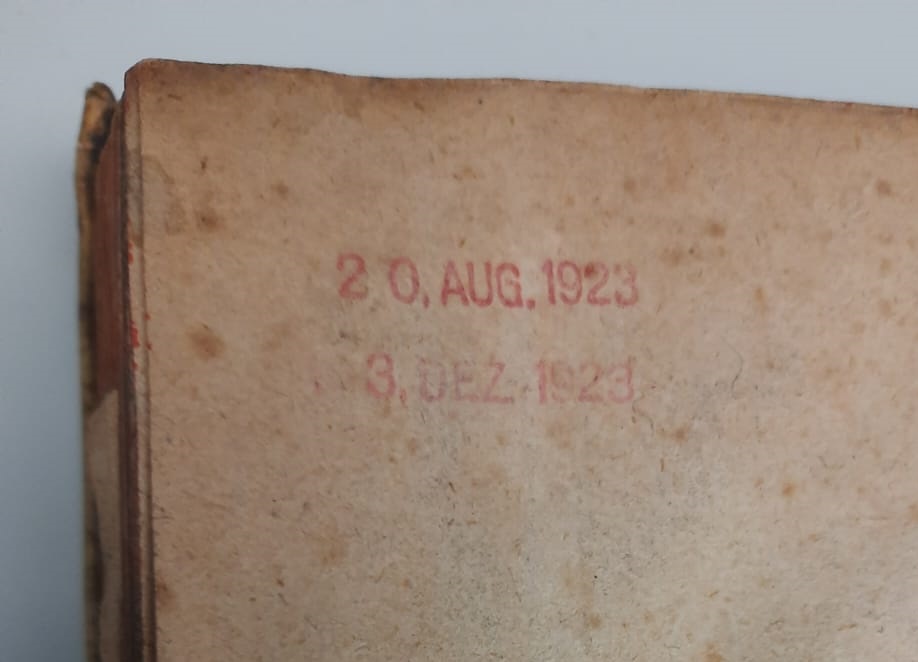 Photo: archive of the Institute ÚVI
Photo: archive of the Institute ÚVI
What type of stamp is this? It likely indicates the date of a stock revision, although it’s unclear why there would be a repetition in December of the same year, especially considering that revisions typically occurred in August (at least in the case of the Kaiser Wilhelm Academy shortly after 1900). However, it seems more probable that it was a revision or another form of book inspection, rather than a record of a loan. It would be implausible for two-thirds of the library’s books to remain untouched for decades without anyone borrowing even the younger volumes. Moreover, these time stamps appear even on rare prints from the mid-17th century, which the contemporary librarian would hardly have allowed to be borrowed outside the study room.
In any case, thanks to these stamps, we have information about the handling of volumes, at least for a significant portion of the collection. As evident from the graph in my 4th advent post, almost all of them fall within the era of the Deutsche Ärzte-Bücherei, with only a few from the older Kaiser Wilhelms-Akademie. Actually, four entries even date back to the time before the end of World War I when the Kaiser Wilhelms-Akademie without a doubt had not yet been dissolved.
Markéta Ivánková, December 20th, 2023
Advent of Lost Berlin Libraries – 19
The number 19 in today’s post stands for the date of January 19th, 1828, when “Generalstaabsarzt Büttner” donated a copy of the book “Materialien- und Naturalien-Magazin” to the Berlin library (today’s K 13403). This is what the green star of “donated to the library” from my 4th advent post looks like in reality:
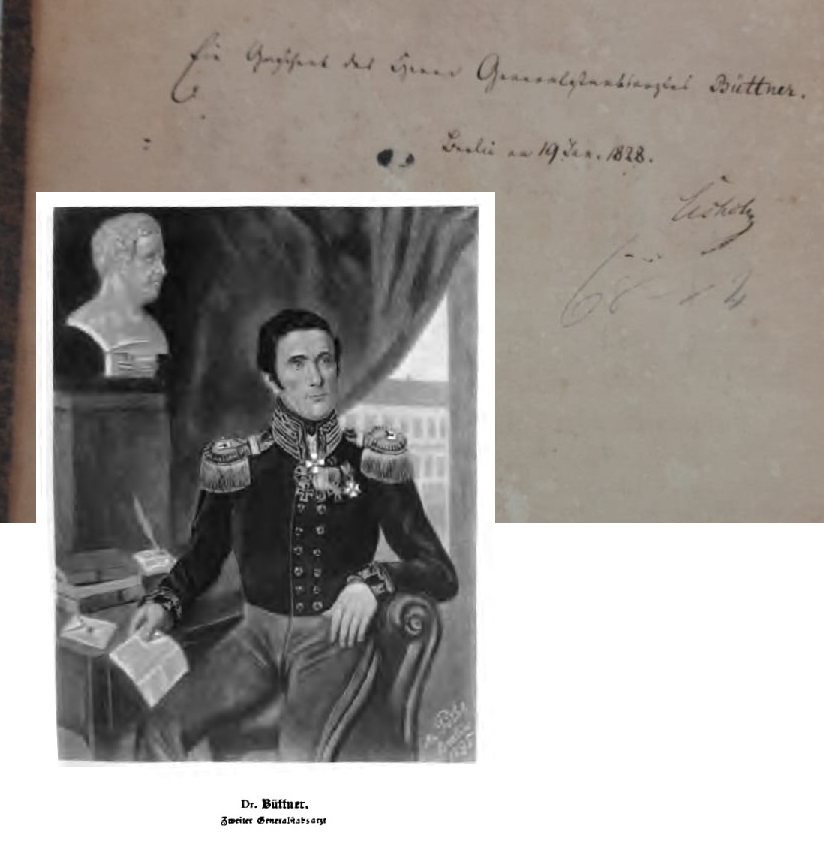 Photo: archive of the Institute ÚVI, portrait: Die Militärärztlichen Bildungsanstalten
Photo: archive of the Institute ÚVI, portrait: Die Militärärztlichen Bildungsanstalten
The text on the front pastedown: “Ein Geschenk des Herrn Generalstaabsarztes Büttner. Berlin am 19. Jan. 1828.” is followed by an unreadable signature. It is uncertain who signed the record of the donation. However, with a bit of imagination, it could be the signature of Johann August Elsholtz (born 1797), who held the position of a “Staabsarzt” at that time.
Dr. Joseph Büttner (1768 – 1844) donated an illustrated overview of medicinal resources, Neu-Eröffnetes Materialien- und Naturalien-Magazin by Pierre Pomet (in the 1727 edition), to the library of the Friedrich-Wilhelms-Institut long before its printed catalogue was published. In both this catalogue and the subsequent catalogue of the Kaiser Wilhelms-Akademie, the book is indeed recorded.
Markéta Ivánková, December 19th, 2023
Schickert: Die Militärärztlichen Bildungsanstalten von inrer Gründung bis zur Gegenwart. Berlin: E. S. Mittler und Sohn, 1895.
Advent of Lost Berlin Libraries – 18
On December 5th, we encountered Berlin shelf-marks that do not correspond to any of the searched catalogues (it was “Font. med. 168”). Today, we will finally discuss the 18 subject categories of these abbreviated shelf-marks (their colour coding is explained in the legend) as well as the hybrid records where these shelf-marks are written with appended numerical shelf-marks that, according to the catalogue, belong to the Friedrich-Wilhelms-Institut.
The content of the abbreviations is relatively easy to deduce. These, so far, 18 abbreviations capture the thematic focus of the book. However, with later shelf-marks, you cannot directly deduce the subject from the shelf-marks themselves; for that, you need a key in the catalogue that assigns numeric values to the described categories.
Unclear, though, was to which library (or part of which library) this series of shelf-marks “Abbreviation.sequential number” belongs. Therefore, I gradually tried to find matches with stamps from the older Pépinière library (which it cannot be, because about half of the books with these shelf-marks do not have a Pépinière stamp at all) and later with various types of provenance records from the Friedrich-Wilhelms-Institut, where the results were more conclusive:
Calculations: Markéta Ivánková
The data are ultimately divided into four groups. The volumes in which the abbreviated shelf-mark has a counterpart in the valid FWI shelf-mark are captured in the leftmost column. The last column represents books that are documented in the FWI catalogue but do not have any “special shelf-mark”. This looks promising; we could define this set of books as part of the FWI between the renaming from Pépinière in 1818 and the creation of the printed catalogue in 1857.
However, it’s not always so straightforward with data on rare prints, and here we find several special cases, namely in the middle two columns. In the third column, there are hybrid shelf-marks – they start with an abbreviation, but a category number is added, along with a sequential number – ie. with the entire shelf-mark corresponding to FWI. This would suggest that these abbreviations could be some initial way of recording shelf-marks in FWI, which was later abandoned.
The second column from the left has 5 books where there is a problem finding a match in the FWI catalogue, and they spoil this nice theory. However, it is not a big deal because one of them has the correct catalogue shelf-marks and the title, and author correspond to the catalogue entry. However, the Berlin catalogues and the book itself do not agree on the edition and year, so I would be cautious and consider this specimen as “unidentified in the FWI catalogue”.
The remaining 4 exceptions are cases where the FWI shelf-mark has not survived in the book to this day, but the title was found in the FWI catalogue, and the volumes also bear the stamp of this library. So, we know what shelf-marks should have been in the books, but I would assume that they disappeared during a repair of damaged bindings, and the sheets they were written on were either removed or pasted over.
It seems, therefore, that the abbreviated shelf-marks could either denote some open-shelves section of the library within the Friedrich-Wilhelms-Institut or it could be books that the librarian began to mark in a new way, which he later abandoned, and he eventually assigned shelf-marks to the entire library as we know them from the 1857 catalogue.
Markéta Ivánková, December 18th, 2023
Katalog der Bibliothek des Kœniglichen medizinisch-chirurgischen Friedrich-Wilhelms-Instituts. Berlin: Druck der Gebr. Unger’schen Hofbuchdruckerei, 1857.
P.S.: Tomorrow’s post is much shorter but no less interesting.
Advent of Lost Berlin Libraries – 17
So far, 17 books have been found in the collection that the KWA library acquired as a “gift from the estate of Prof. A. Hirsch”, as indicated by the stamp appearing in these volumes:
Photo: archive of the Institute
August Hirsch (1817–1894), before baptism Aron Simon Hirsch, was a hygienist and medical historian renowned for his monograph Handbuch der historisch-geographischen Pathologie. It is not surprising that the books examined during the research are thematically closely related to his interests and specialization (according to the KWA catalogue, they were later classified into categories such as “Oriental Plague”, “Dysentery”, “Typhus abdominalis”, “Measles”, “Scarlatina”, “Medical treatises and observations” or “Handbooks and Textbooks” of internal medicine, and finally “General handbooks of medicine” and “Medical Travelogues”).
In 1896, the personal library of August Hirsch, which reportedly contained approximately 10,000 volumes, became part of the collection of the Kaiser Wilhelms-Akademie für das militärärztliche Bildungwesen. It then constituted a significant portion of its library – only six years later, including Hirsch’s collection, it totalled 58,000 volumes. It was a generous gift.
The 17 found copies represent only a tiny fraction of the entire Hirsch library, but they contain the oldest volumes – especially in the examined collection of the Institute for History of Medicine, where only the oldest books are located. Even in their company, Hirsch’s copy of Jacopo Tronconi’s De peste, et pestilenti morbo libri quatuor from 1578 is an exceptional title.
Markéta Ivánková, December 17th, 2023
Advent of Lost Berlin Libraries – 16
Today marks exactly 80 years since December 16th, 1943 – on that day, the loan period of the New system of midwifery by R. W. Johnson from 1782 was set to expire. At least, that’s what we learn from the slip inserted in this book, which the reader fortunately returned, and perhaps even on time:
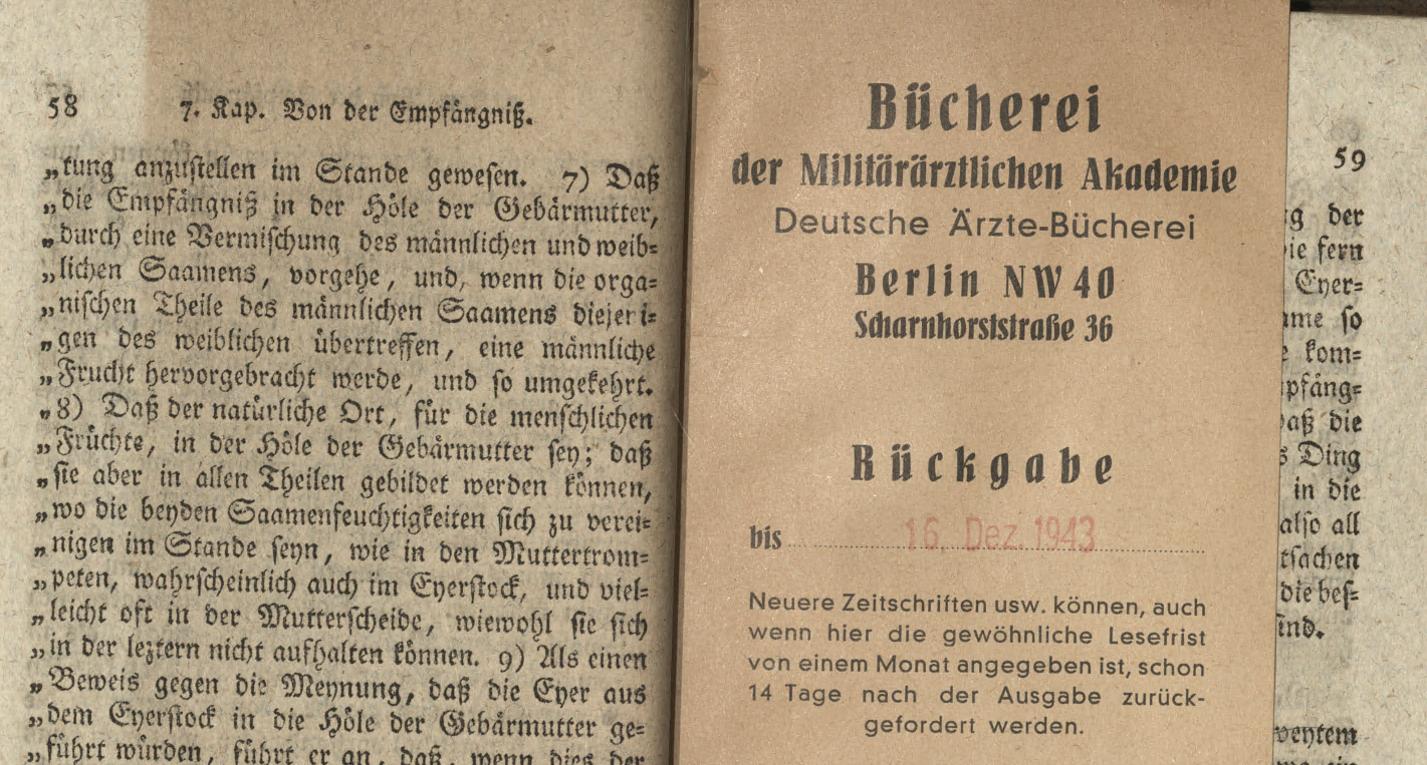 Photo: archive of the Institute
Photo: archive of the Institute
The paper, with its acidity, has left permanent traces on the book’s pages – judging by the outline, it stayed in this place for a very long time and didn’t end up there randomly: it hasn’t recently fallen out of another book. It can reasonably be assumed that the slip has been in this place since the end of 1943.
Why is random information about when and where this specific book was supposed to be returned so valuable? It is the youngest evidence of the presence of this collection in Berlin – as part of the Deutsche Ärzte-Bücherei – that has emerged from my current research of individual volumes. Although I have dated the library stamps of the Deutsche Ärzte-Bücherei en bloc “no later than 1945”, the youngest date from all the time stamps in the Berlin collection of rare prints at the 1st Faculty of Medicine lies in front of us on this inconspicuous piece of paper.
Markéta Ivánková, December 16th, 2023
Advent of Lost Berlin Libraries – 15
For the number 15, I selected the 15th title in the category of general pathology from the Kaiser-Wilhelms-Akademie library – also the category discussed yesterday. On the preceding page (209), under the shelf-mark 90.15, the book is recorded as follows: “Wolff, P. Physica Hippocratica, qua exponitur humanae naturae mechanismus geometrico-chymicus. Lipsiae 1713.“ The spine of the copy is photographed in the picture:
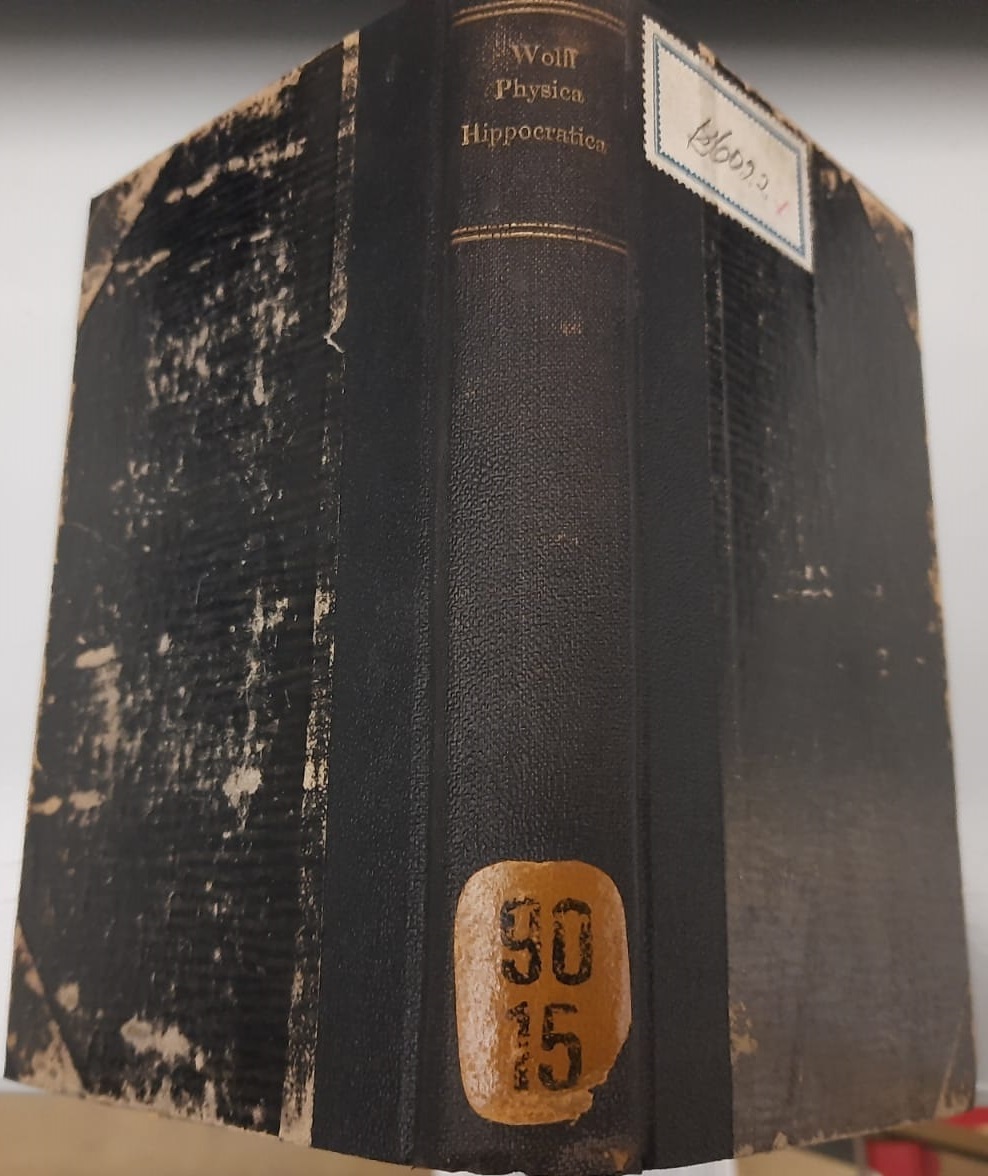 Photo: archive of the Institute
Photo: archive of the Institute
Today, the book is catalogued under the shelf-mark K 6022 (on the front cover). However, today I want to focus on the orange sticker with the Kaiser-Wilhelms-Akademie signature on the spine. The binding looks identical to the book from December 13th – author, abbreviated title, and a decorative stripe are foil-stamped. However, an orange printed sticker is placed where the foil-stamped shelf-mark would be. In the Berlin collection, this rounded rectangle is common, appearing on approximately 120 volumes out of nearly 300 identified books.
The shelf-mark of the Friedrich-Wilhelms-Institut is not extant on the book’s pages, but its stamp (the one I refer to as number 6, valid until 1895) is. In the catalogue, this title can be traced as shelf-mark 87.10 (on page 262) among textbooks and handbooks of general pathology and therapy.
I won’t look under the sticker on the spine: the conservator in charge of the collection wouldn’t be pleased. Therefore, it cannot be easily ruled out that the orange sticker, matching the KWA shelf-mark, covers an older FWI shelf-mark. Or, there might be no older signature underneath at all – the binding may date back to the time of the Kaiser Wilhelms-Akademie, and an older shelf-mark on the pastedown or flyleaf may have been lost during rebinding.
Markéta Ivánková, December 15th, 2023
KWA: Verzeichnis der Büchersammlung der Kaiser Wilhelms-Akademie für das militärärztliche Bildungswesen. (Dritte Ausgabe). Berlin: Verlag von August Hirschwald. Unter den Linden 68, 1906.
FWI: Katalog der Bibliothek des Kœniglichen medizinisch-chirurgischen Friedrich-Wilhelms-Instituts. Berlin: Druck der Gebr. Unger’schen Hofbuchdruckerei, 1857.
Advent of Lost Berlin Libraries – 14
14 is the highest number of books on one page in the catalogue of the Kaiser Wilhelms-Akademie. The most filled page so far is page 210, which contains a list of books from category number 90: “Lehrbücher und Abhandlungen der allgemeinen Pathologie” (textbooks and treatises on general pathology). Below is a histogram analogous to the one I used to answer the same question for the Friedrich-Wilhelms-Institut:
Calculations: Markéta Ivánková
The topic is different from what we’ve found on the most filled page of the Friedrich-Wilhelms-Institut catalogue (there, it was on obstetrics). And the number is higher, which is also due to the fact that the FWI catalogue has a longer catalogue-record text, hence fewer entries fit on one page – only 13 title descriptions (there is a match with our library only for 5 shelf-marks, describing 7 volumes).
The catalogue of the Kaiser Wilhelms-Akademie captures the state of the library in 1906, and on the above-mentioned page 210, there are a total of 36 titles (90.37 to 90.72), of which 14 were identified in the collection of rare prints at the 1st Faculty of Medicine, which is just under half of the Berlin-catalogue page.
Markéta Ivánková, December 14th, 2023
Verzeichnis der Büchersammlung der Kaiser Wilhelms-Akademie für das militärärztliche Bildungswesen. (Dritte Ausgabe). Berlin: Verlag von August Hirschwald. Unter den Linden 68, 1906.
Katalog der Bibliothek des Kœniglichen medizinisch-chirurgischen Friedrich-Wilhelms-Instituts. Berlin: Druck der Gebr. Unger’schen Hofbuchdruckerei, 1857.
Advent of Lost Berlin Libraries – 13
The book with the Kaiser-Wilhelms-Akademie shelf-mark 175.13 has an interesting binding and spine marked with the number 13. The category number 175 in the KWA catalogue stands for “Tuberkulose und Skrofulose (Phthisis pulmonum)”. However, this time we won’t focus on the content of the book but rather on the form of the external provenance marking of the volume:
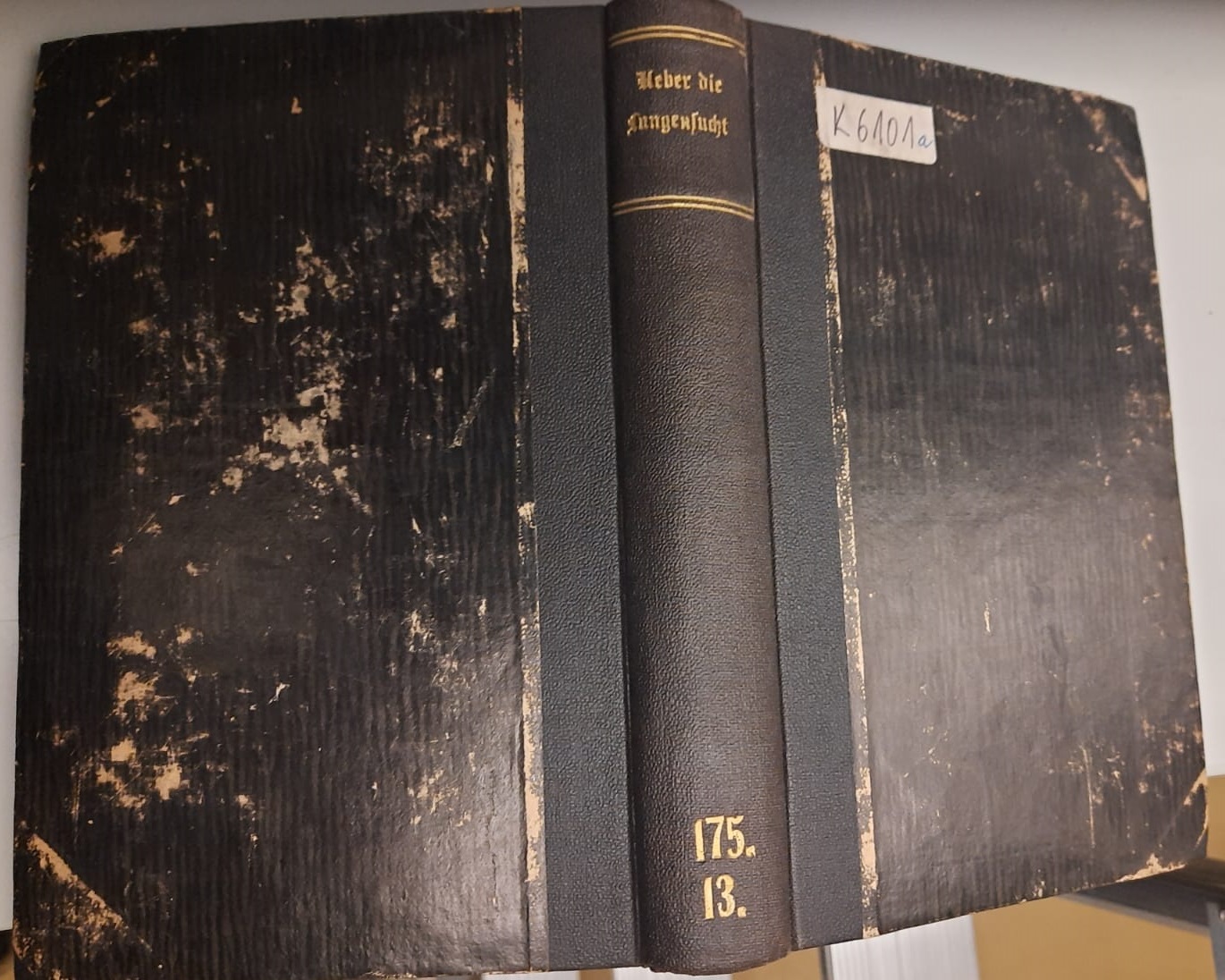 Photo: archive of the Institute ÚVI
Photo: archive of the Institute ÚVI
In the collection of rare books at the Institute for History of Medicine of the 1st Faculty of Medicine, Charles University, there are several ways in which the spines of Pépinière and its successors are marked. One of them is the foil-stamped “175.13.” in gold colour.
Kaiser Wilhelms-Akademie, indicated by this shelf-mark, is a more recent library. In the collection, there are a few cases where an older foil-stamped shelf-mark corresponding to its predecessor (the Friedrich-Wilhelms-Institut) is present on the spine, even though the volume later received a newer KWA signature, as documented in its catalogue and by the provenance entries inside the volume.
Berlin librarians clearly tried to keep the spines of the books up-to-date. This, however, doesn’t necessarily mean that their re-labelling couldn’t have come off later, leaving only the older shelf-mark visible. However, what we have here is an exemplary case where the Kaiser Wilhelms-Akademie shelf-mark on the spine is still visible today.
Markéta Ivánková, December 13th, 2023
Advent of Lost Berlin Libraries – 12
The stamp with the inscription “Hygiene-Museum” is in a sense the 12th one, although a more accurate designation would be H2a and H2b for each variant (and with the yesterday’s “11” corresponding to H1). I briefly mentioned this museum yesterday, and today I will provide some additional context. It is the second organization belonging to the university “hygiene institutes” in Berlin:
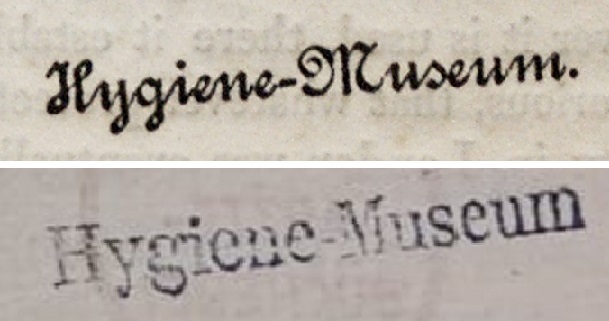 Photo: archive of the Institute ÚVI
Photo: archive of the Institute ÚVI
The Hygiene-Museum was officially established in 1883, with exhibits from a previous exhibition forming the basis of the collection, eventually turning into a permanent exhibition. The Hygiene-Museum supposedly opened at the university in 1886. I have found this stamp in a total of five books. It is never alone: it always appears simultaneously with the “Bibliothek der HYGIENISCHEN JNSTITUTE der Königl. Universität”, described yesterday. However, it is not present in all copies marked as property of the Library of the Hygiene Institutes.
The provenance of the “Hygiene-Museum” undoubtedly forms a single entity with the “Bibliothek der hygienischen Institute”, which originally existed separately but, as proved by one copy bearing the stamps of both hygiene institutions and stamp no. 9 of the Deutsche Ärzte-Bücherei, it ended up in the DÄB collection, similarly as Pépinière.
The non-Pépinière stamps 11 and 12 partially clarify the cases of “zero stamps” in the previous charts, where books belonging to the Pépinière provenance branch alone have their codes. Seven instances of “zero provenance stamps” are thus explained. There remain several books that do not bear Pépinière and its successors’ stamps, but they have shelf-marks matching their catalogues – which means they belonged these libraries, only the stamps were not preserved.
Markéta Ivánková, December 12th, 2023
Die naturwissenschaftlichen und medicinischen Staatsanstalten Berlins. A. Guttstadt (ed.). Berlin: August Hirschwald, 1886.
Advent of Lost Berlin Libraries – 11
The Pépinière Library and its successors have only 10 stamps appearing in our collection of rare prints. However, this list of stamps does not end there, as there is also a related 11th stamp, which presumably belongs to Berlin libraries too, appearing simultaneously with the provenance of the Deutsche Ärzte-Bücherei. It is associated with another institution whose library was subsequently transferred to the Deutsche Ärzte-Bücherei, and these books coincidentally remained together. The text of the stamp reads: “Bibliothek der HYGIENISCHEN JNSTITUTE der Königl. Universität”:
 Photo: archive of the Institute ÚVI
Photo: archive of the Institute ÚVI
I haven’t been able to independently confirm this yet, as Berlin is not explicitly mentioned, but it could be the stamp of the Library of the Hygiene Institutes of the Royal University, meaning, the Königliche Friedrich-Wilhelms-Universität in Berlin. In that case, these two institutions would refer to the “Hygiene-Laboratorium”, whose first regular professor from 1885 was Robert Koch himself, and to the “Hygiene-Museum”, which he also directed. The term “Hygienische Institute” is, in fact, collectively used for then in the overview of natural-sciences and medical institutions in Berlin, published in 1886.
How common is this provenance? So far, this stamp has appeared eight times, sharing its fate with the Pépinière provenance branch – it is connected to it only by the Deutsche Ärzte-Bücherei stamp, and that in a single copy.
Markéta Ivánková, December 11th, 2023
Die naturwissenschaftlichen und medicinischen Staatsanstalten Berlins. A. Guttstadt (ed.). Berlin: August Hirschwald, 1886.
Advent of Lost Berlin Libraries – 10
Today’s graph depicts all 10 types of stamps used by the Pépinière and its successors, grouped by the time they were valid. Colour is assigned to individual stamp types, rather than to the institutions. The date on the x-axis, marking the end of the respective libraries, denotes the last time the stamp could be inserted into the book:
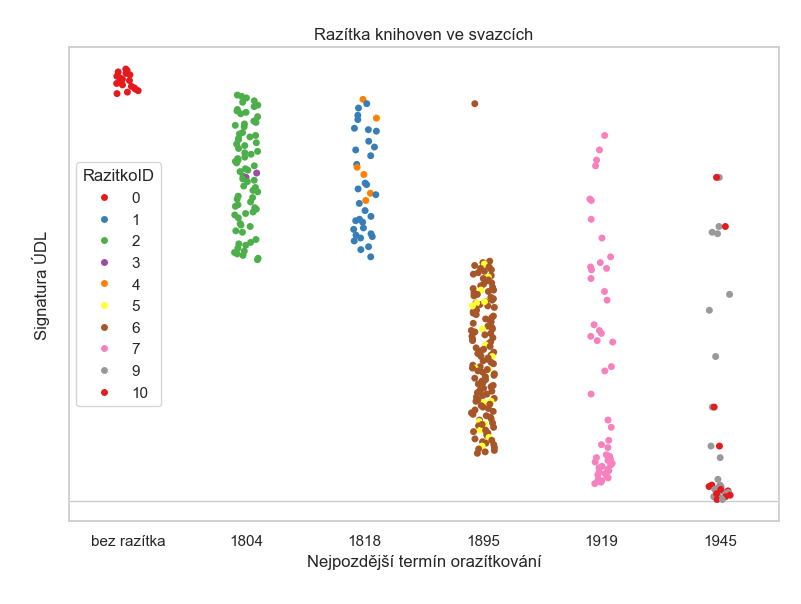 Calculations: Markéta Ivánková
Calculations: Markéta Ivánková
This time, the data is distributed within a vertical strip plot. And we can observe a different visualization of disjunctive stamp clusters of Pépinière (until 1804 and 1818) and of the subsequent Friedrich-Wilhelms-Institut (1895). (Yes, there is the singular dot not abiding by the rules…). It is easy to discern that the last two libraries (the KWA and the DÄB) seldom re-stamped already marked books but when they did, they did not differentiate between the previous owners.
Markéta Ivánková, December 10th, 2023
Advent of Lost Berlin Libraries – 9
Among the books that used to be in the oldest Pépinière, there are 9 items that are marked as property of the Kaiser-Wilhelms-Akademie (yellow circles in the graph). The only green stamp of the Friedrich-Wilhelms-Institut is the above mentioned exception that proves the rule. However, the low count of stamps is compensated for by persistent and systematic appearance of the books in the catalogue entries of those libraries – the shelf-marks listed in the catalogues are identical with the older shelf-marks in respective books. Remember, the round marks of the institutions’ stamps are dated to the last known date when they could have been added into the book because after that, the library did not exist under that name any longer:
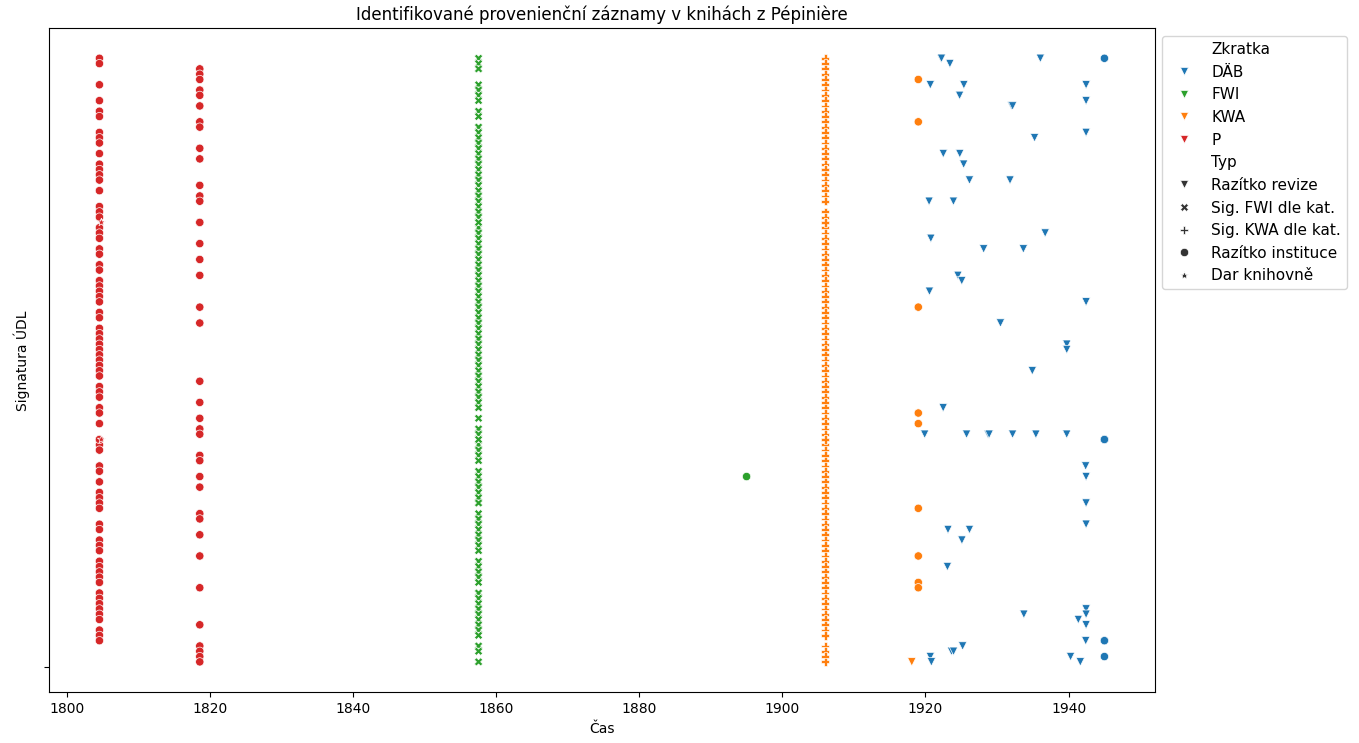 Calculations: Markéta Ivánková
Calculations: Markéta Ivánková
When we consider that 115 Pépinière books have been identified so far, it is clear that under no circumstances would it be enough to rely solely on the libraries’ stamps when identifying the collection. The information on individual books, based only on the “round markers in the graph” would be scarce, we would have to settle for a hypothesis that the books should – logically – have been owned by the Pépinière’s successors as well. In other words: without the catalogues and old shelf-marks, our evidence would be circumstantial and rather weak.
And last but not least, I have to mention that among these Pépinière books, there are four volumes with stamps from the youngest Berlin provenance layer, of the Deutsche Ärzte-Bücherei. What is more, there is an interesting number of time-stamps at endpapers – again from the period which (almost entirely) corresponds to the time of the Deutsche Ärzte-Bücherei.
Markéta Ivánková, December 9th, 2023
Advent of Lost Berlin Libraries – 8
The ID of the stamp that has not yet been mentioned in the calendar, is 8. It is present in the collection of rare prints, and I am aware of it being there. However, in the processed initial third of the collection, there is not a single instance of its occurrence. Hence, the number eight is absent from the histogram representing occurrences of library stamps. A zero indicates that none of these stamps have remained in the book.
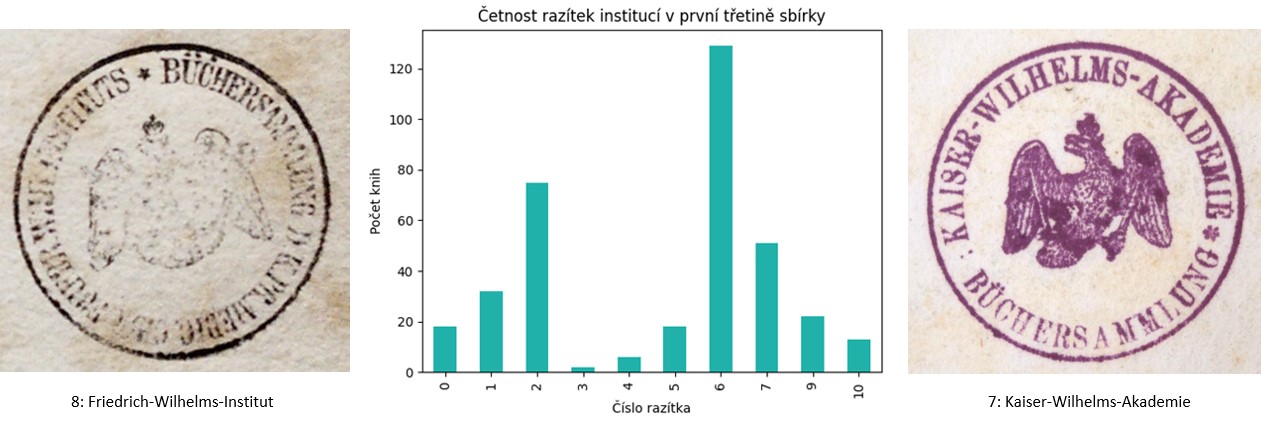 Photo: archive of the Institute, calculations: Markéta Ivánková
Photo: archive of the Institute, calculations: Markéta Ivánková
What does the stamp convey? It indicates that it is part of the Collection of Books of the Royal Prussian Medical-Surgical Institute of Friedrich Wilhelm: “BÜCHERSAMMLUNG D. K. PR. MEDIC. CHIR. FRIEDR. WILH. INSTITUTS.” This is the third time in a row we focus on the FWI, and for a good reason. Identifying this stamp proves to be surprisingly challenging.
The “eight” resembles a stamp of the direct successor of this library, namely the Kaiser-Wilhelms-Akademie, established in 1895. At first glance, these stamps can easily be distinguished by a star and text positioned above the eagle’s head (“Büchersammlung” in 8, while 7 declares “Kaiser-Wilhelms-Akademie” and “Büchersammlung” is written only in the lower half of the circle). This differentiation is evident and straightforward under ideal conditions of a clear imprint on smooth paper. In practice, however, the letters are often illegible, blurred on handmade or damaged paper, and distinguishing them requires more concentration than it would seem at first glance.
Markéta Ivánková, December 8th, 2023
Advent of Lost Berlin Libraries – 7
Number 7 represents the highest count of books owned by the Institute for History of Medicine on a catalogue page of the Friedrich-Wilhelms-Institut. The most filled page is page number 493. We will once again focus on the Medizinisch-chirurgisches Friedrich-Wilhelms-Institut, however, the graph of the day is a histogram:
Calculations: Markéta Ivánková
Eight titles aggregated on “page 1000” are not considered. Just as in the case of the parallel strip plot from December 2nd, entries from the 1st and 2nd supplementary catalogues of the library are all recorded as if they were on page 1000, which does not actually exist and is beyond the range of pages in the 1857 catalogue. There is only one actual match in the supplements: two titles on page 104 of the 2nd supplement.
What do the books listed on page 493 discuss and why were they in the library? Category number 165 is provided with the description “Textbooks and Handbooks of Obstetrics”. Indeed, according to the institute’s syllabus in 1819, theoretical and practical obstetrics lessons took place in the 7th semester. It certainly did not focus solely on military medicine needed “on the battlefield”. On the contrary, the initial Pépinière started as a military institution primarily for the training of surgeons but with a significant overlap. It was soon renamed to the more general Medizinisch-chirurgische Pépinière and the Medizinisch-chirurgisches Friedrich-Wilhelms-Institut clearly carried on that tradition.
Markéta Ivánková, December 7th, 2023
Katalog der Bibliothek des Kœniglichen medizinisch-chirurgischen Friedrich-Wilhelms-Instituts. Berlin: Druck der Gebr. Unger’schen Hofbuchdruckerei, 1857. Together with the supplemental catalogues from 1877 and 1883.
Preuß, J. D. E.: Das Königlich Preußische medizinisch-chirurgische Friedrich-Wilhelm’s-Institut (ursprünglich chirurgische Pépinière) zu Berlin. Ein geschichtlicher Versuch zum 25ten Stiftungstage desselben dem 2ten August 1819. Berlin: Gedruckt in der Ungerschen Buchdruckerei, 1819.
Advent of Lost Berlin Libraries – 6
In the Berlin collection, the stamp number 6 is most common, making the Friedrich-Wilhelms-Institut the winner of the competition. The text of the round stamp reads: “KOENIGL. MEDICIN. CHIRURG. FRIEDRICH WILHELMS. INSTITUT” and forms the left half of today’s illustration. Next to it, I have included another view of my 3D model of stamp occurrences, this time with marked occurrences of the “six”:
We have already established that the Friedrich-Wilhelms-Institut did not stamp over older Pépinière stamps (1–4) and the possible reasons behind it. The only book that simultaneously has 6 and 1 will be a proverbial exception that proves the rule, and in the overall number of copies, it is not significant. Number 5 is the second alternative of the FWI stamp, however, without the coat of arms and with an oval shape.
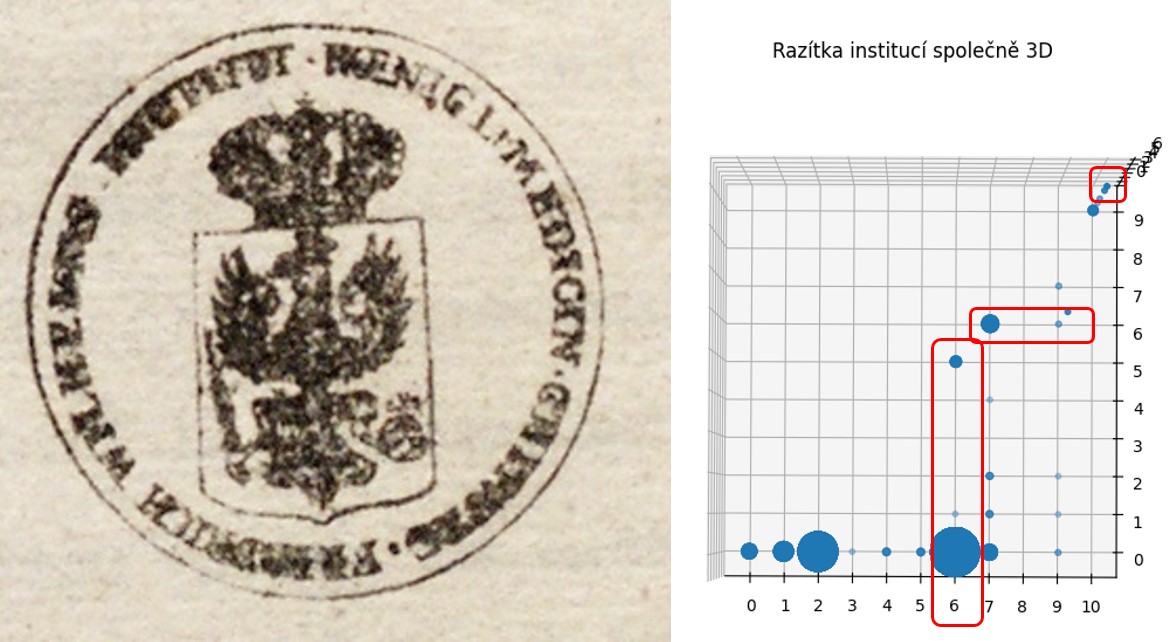 Photo: archive of the Institute, calculations: Markéta Ivánková
Photo: archive of the Institute, calculations: Markéta Ivánková
The Medizinisch-chirurgisches Friedrich-Wilhelms-Institut originated on August 9, 1818, by renaming Pépinière, and it changed to Kaiser Wilhelms-Akademie für das militärärztliche Bildungswesen at the beginning of December 1895 – on the occasion of celebrating the 100th anniversary of the original Pépinière’s founding. Kaiser Wilhelms-Akademie frequently added its new stamp to the preceding “six” of Friedrich-Wilhelms-Institut (I have counted 21 such pairs). This time, they did not hide their pride in the emperor’s honour when he bestowed his name upon them, and after a hundred years, there was likely no dispute about the continuity of the institutions.
The last combination of the FWI stamp remains only with the interwar Deutsche Ärzte-Bücherei (9 and 10). One trio of 6 occurs with both variants of the Deutsche Ärzte-Bücherei, twice, 6 appears only with the complete name Deutsche Ärzte-Bücherei (9). The second trio consists of 6 with the complete name Deutsche Ärzte-Bücherei (9) and the oval stamp of its own institution FWI (5). In this group, there are not many occurrences, and with such a small number of books, no system of DÄB stamping can be traced so far.
Markéta Ivánková, December 6th, 2023
Preuß, J. D. E.: Das Königlich Preußische medizinisch-chirurgische Friedrich-Wilhelm’s-Institut (ursprünglich chirurgische Pépinière) zu Berlin. Ein geschichtlicher Versuch zum 25ten Stiftungstage desselben dem 2ten August 1819. Berlin: Gedruckt in der Ungerschen Buchdruckerei, 1819.
Schmidt, H.: Die Kaiser Wilhelms-Akademie für das militäräztliche Bildungswesen. Von 1895 bis 1910. Festschrift zur Einweihung des Neubaues der Akademie. Im Auftrage der Medizinal-Abteilung des Königlichen Kriegsministeriums. Berlin: G. S. Mittler & Sohn, 1910.
Advent of Lost Berlin Libraries – 5
Five books are marked with the shelf-mark “Font. med.”, followed by the sequential number of the book in the category. This is an abbreviation for “Fontes medicinales”, which later appears in catalogues as “Bäder und Heilquellen” (mineral healing springs and spa) with a subcategory of monographs. I have no doubt that 5 is not the final number, this count applies to the already processed part of the collection of rare prints at the faculty’s library in Prague.
Today’s illustration comes from the book now labelled as K 6317. Let’s borrow the oldest entry in the catalogue of the Friedrich-Wilhelms-Institut, where on page 256 under the shelf-mark 86. a. 103, it states: “Am Stein: Ueber das Wesen und die Heilkräfte des Pfefferser Wasses. An Dr. Schinz. (Bregenz 1804.) 8vo. 1 Bd.” The same shelf-mark is also inscribed – later crossed out as invalid and outdated – above the title of the work. This time, however, let’s focus on the shelf-mark in the upper right corner of the page:
Upon closer inspection, you will notice that the sequential number with the “abbreviated shelf-mark” is not only harder to read but also incomplete. The pages of the book block were evidently trimmed during rebinding, and part of the last digit suffered. Let’s consider it as the number 168, although theoretically, reading 165 is also possible—it would have to be an atypical five, though. It’s worth mentioning that at least the original green strip from the spine of the old binding has been preserved.
Remember the shelf-marks “Abbreviation.number”, we will return to them in more detail on December 18th.
Katalog der Bibliothek des Kœniglichen medizinisch-chirurgischen Friedrich-Wilhelms-Instituts. Berlin: Druck der Gebr. Unger’schen Hofbuchdruckerei, 1857.
Markéta Ivánková, December 5th, 2023
Advent of Lost Berlin Libraries – 4
A chronological overview of the provenance of the “Berlin collection” of old prints has four colours representing the institutions to which the books gradually belonged. The oldest one, Pépinière, is depicted in red, Friedrich-Wilhelms-Institut in green, Kaiser Wilhelms-Akademie in yellow, and Deutsche Ärzte-Bücherei in blue. The shapes of the markers further specify the types of records. And the time flows to the right:
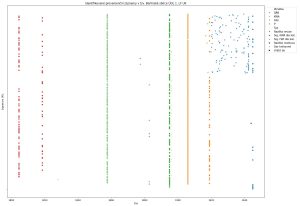 Calculations: Markéta Ivánková
Calculations: Markéta Ivánková
299 books have been identified (from the 816 items that have been processed so far) and you can see over one thousand ownership records depicted in this illustration. No Santa’s elf was harmed while drawing the image, my Python script was glad to help.
Markéta Ivánková, December 4th, 2023
Advent of Lost Berlin Libraries – 3
The highest number of Berlin stamps in a single copy at the same time is 3, at least in the processed part of the collection. That’s why I projected the occurrences of institutional stamps into a 3D representation. Each stamp has its assigned numerical code because their texts are too long and confusing. Pépinière has four types (1, 2, 3, and 4), three belong to Friedrich-Wilhelms-Institut (5, 6, and 8), 7 designates Kaiser Wilhelms-Akademie, and finally, 9 and 10 belong to Deutsche Ärzte-Bücherei:
Calculations: Markéta Ivánková
What can be deduced from the graphics? For example that in the library of the Friedrich-Wilhelms-Institut, copies marked Pépinière were not re-stamped, so it almost always holds true that a book either has an older Pépinière stamp or only its successor. In the Festschrift for the 25th anniversary of Pépinière – which was already named Friedrich-Wilhelms-Institut at that time – the continuity of the institution was emphasized, and from these records in the books, it seems that these were not just empty phrases.
A common occurrence is the pair of 6-7 (FWI-KWA). And finally, the third layer used to be the designation of the interwar library Deutsche Ärzte-Bücherei, which added at least 9 – and apart from a few missing cases – simultaneously also the shortened stamp no. 10.
Markéta Ivánková, December 3rd, 2023
Advent of Lost Berlin Libraries – 2
While determining the extent of our “Berlin collection”, I cross-checked the books’ entries in catalogues of 2 former libraries: Bibliothek des Kœniglichen medizinisch-chirurgischen Friedrich-Wilhelms-Instituts from 1857 (including the supplementary catalogues from 1877 and 1883) and the successive Kaiser Wilhelms-Akademie für das militärärztliche Bildungswesen, in the 1905-edition.
Each dot represents an entry in a book that is marked by the same numeric shelf-mark, which appears in the respective catalogue – and has the same information on the author, title, and edition. Here is the outcome of the analysis of the first third of our rare-prints collection:
Calculations: Markéta Ivánková
And the blue dots on the non-existing page 1000 of the FWI-catalogue? Those stand for all items that appear in the two later supplements.
Katalog der Bibliothek des Kœniglichen medizinisch-chirurgischen Friedrich-Wilhelms-Instituts. Berlin: Druck der Gebr. Unger’schen Hofbuchdruckerei, 1857. Together with the supplemental catalogues from 1877 and 1883.
Verzeichnis der Büchersammlung der Kaiser Wilhelms-Akademie für das militärärztliche Bildungswesen. (Dritte Ausgabe). Berlin: Verlag von August Hirschwald. Unter den Linden 68, 1906.
Markéta Ivánková, December 2nd, 2023
Advent of Lost Berlin Libraries – 1
The first in a series of contributions to the Advent of Lost Berlin Libraries features the stamp of Dr. Johann Goercke, Geheimer Obermedizinalrat, marking a volume with the current shelf-mark K 6242. Johann Goercke (1750 – 1822) proposed the establishment of the Prussian Surgical Pépinière in 1795 for the systematic education of military surgeons, calculated the costs, and convinced the king of the institution’s necessity. The Pépinière’s library was established two years later and is the first in the sequence of the “Berlin Collection” of rare prints at the library of the 1st Faculty of Medicine.
Advent of Lost Berlin Libraries is a series of short contributions with interesting facts that I have discovered during the ongoing research of the project Traces of Lost Libraries: Berlin, where I am mapping ownership of the oldest part of our faculty’s collection of rare prints.
On November 29, 2023, it was presented at the conference Archives, Libraries, Museums in the Digital World 2023.
Markéta Ivánková, December 1st, 2023


